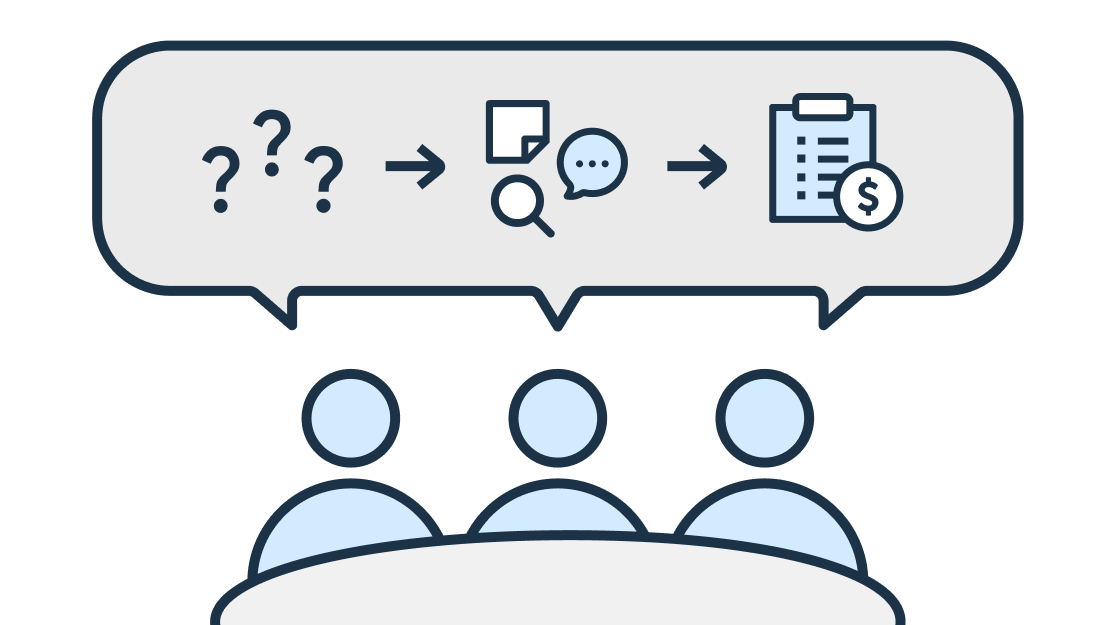Building for impact with product discovery
|

The Lab Services team partners with ministries to establish new digital delivery teams and coach existing teams, helping them develop their digital skills. This support enables ministries to adopt the Digital Code of Practice (DCOP) and comply with the new Chapter 12 Core Policy.
Join us for this blog series, where we share tested practices and invite others to reflect and share theirs.
How do I decide to build a digital product or service?
There’s huge buzz around the potential of digital technology to tackle public policy challenges. At Lab Services, we encounter teams all the time who are exploring new ideas. But where should you start?
Which policy challenges are best suited to technology solutions, and how should we start building to have the biggest impact as we scale?
The answer is product discovery, where teams work to understand the problem to solve and the people they serve. Product discovery can be split into three distinct perspectives:
- User need
- Feasibility
- Public value
User need: Should it be built?
Design research (sometimes called user research) is the study of people who use your service, how they behave, and their motivations for using the service.
To conduct design research, your ministry’s Information Management Branch (IMB) or Information Security Branch may have skilled service designers on hand or be able to contract one. Contractors can often conduct user research for less than $75,000. This is a small investment, considering digital product teams can cost upwards of $1.5 million per year and misunderstanding user needs is a common reason for failure.
The Ministry of Citizens’ Services’ Government Digital Experience (GDX) division can conduct design research, or the Digital Marketplace can procure a service designer via Code with Us.
Alongside design research, there are several ways your policy teams can gather information and insights. They can explore what other government entities are doing, review existing research and literature on similar projects and initiatives, and consult with industry experts and organizations. If capacity allows, it’s also a good idea to have your wider team engage in service design training to ensure research outputs are well understood and can be built on.

Feasibility: Can it be built?
Design research is likely to unearth some problems that need to be solved. Those problems aren’t always what was expected, making it tempting to file the findings and move on.
To avoid this, good product discoveries will start to consider solutions, even if they reach beyond the responsibility of the team that commissioned it. Those ideas can then be more readily shared across a ministry or government.
IMBs often have architects who can reflect on users’ challenges and how digital technology could help. Others in government tackling similar problems may also be able to assist, particularly those leveraging Common Components. If solving users’ challenges requires aligning with the technology of other organizations (like municipalities), a contractor may be needed to assess the feasibility of working with those systems.
Data architecture, as set out in the Provincial Data Plan, may be a consideration depending on the size and complexity of data to be accessed or transformed by a new digital product.
Public value: Should we be the ones to build it?
Before deciding whether to proceed with further development, a final perspective is required: Should this be built by us right now?
To answer this, the idea needs to be assessed against ministerial priorities and alternative approaches to the same policy challenge. Could a change in legislation remove the need for a digital product entirely? Or are there other digital products that would be more effective?
It will also involve an understanding of the likely cost, as ministries and IMBs are given a limited budget to allocate to competing priorities. It is worth checking in with your IMB, as they sometimes have governance in place to help teams understand how important their digital product idea is relative to others. This ensures your project is prioritized correctly and aligns with government’s overall strategic objectives.
Getting it built
Having answered these three perspectives on your policy challenge, the next step is to connect with the digital teams and supports capable of securing funding and building the product. Digital projects are usually initiated with operational funding, which covers day-to-day expenses for regular business functions and service delivery.
Keep in mind that discovery is not just the first step of digital development. It’s an ongoing activity that helps products and services respond to a changing world. Teresa Torres, an internationally acclaimed author, speaker and coach, calls this continuous discovery. She teaches a structured and sustainable method that helps product teams infuse their daily product decisions with user input.
By taking a thoughtful and continuous approach to product discovery, we can maximize the value our products and services deliver to the public.
About the author
David King is the lead advisor at Lab Services in the Ministry of Citizens’ Services. He loves hearing about difficult policy challenges and networking across government to help solve them. Previously he worked in the Economic Strategy Branch in JEDI, and the UK Government in a range of policy and delivery roles.
